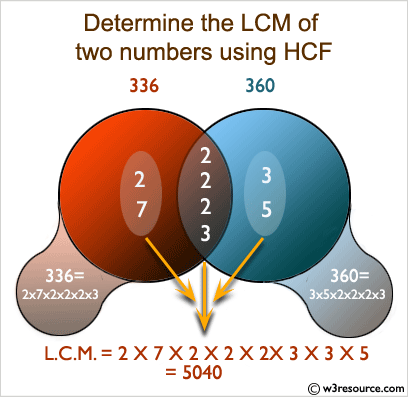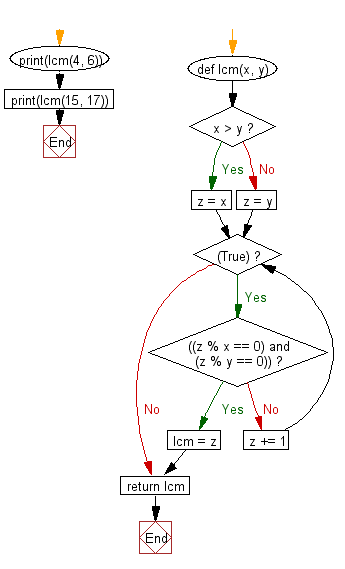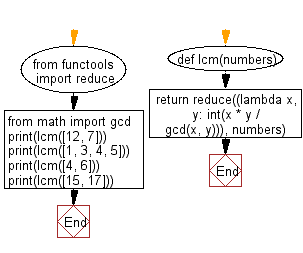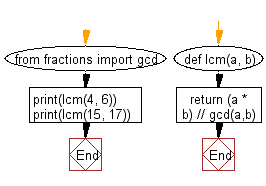Python: Least common multiple (LCM) of two positive integers
Python Basic: Exercise-32 with Solution
Write a Python program to get the least common multiple (LCM) of two positive integers.
From Wikipedia,
In arithmetic and number theory, the least common multiple, lowest common multiple, or smallest common multiple of two integers a and b, usually denoted by lcm(a, b), is the smallest positive integer that is divisible by both a and b. Since division of integers by zero is undefined, this definition has meaning only if a and b are both different from zero. However, some authors define lcm(a,0) as 0 for all a, which is the result of taking the lcm to be the least upper bound in the lattice of divisibility.
Pictorial Presentation:

Sample Solution-1:
Python Code:
def lcm(x, y):
if x > y:
z = x
else:
z = y
while(True):
if((z % x == 0) and (z % y == 0)):
lcm = z
break
z += 1
return lcm
print(lcm(4, 6))
print(lcm(15, 17))
Sample Output:
12 255
Flowchart:

Visualize Python code execution:
The following tool visualize what the computer is doing step-by-step as it executes the said program:
Sample Solution-2:
Use functools.reduce(), math.gcd() and lcm(x,y) = x * y / gcd(x,y) over the given list.
Python Code:
from functools import reduce
from math import gcd
def lcm(numbers):
return reduce((lambda x, y: int(x * y / gcd(x, y))), numbers)
print(lcm([12, 7]))
print(lcm([1, 3, 4, 5]))
print(lcm([4, 6]))
print(lcm([15, 17]))
Sample Output:
84 60 12 255
Flowchart:

Visualize Python code execution:
The following tool visualize what the computer is doing step-by-step as it executes the said program:
Sample Solution-3:
Python Code:
from fractions import gcd
def lcm(a, b):
return (a * b) // gcd(a,b)
print(lcm(4, 6))
print(lcm(15, 17))
Sample Output:
12 255
Flowchart:

Visualize Python code execution:
The following tool visualize what the computer is doing step-by-step as it executes the said program:
Python Code Editor:
Have another way to solve this solution? Contribute your code (and comments) through Disqus.
Previous: Write a Python program to compute the greatest common divisor (GCD) of two positive integers.
Next: Write a Python program to sum of three given integers. However, if two values are equal sum will be zero.
What is the difficulty level of this exercise?
Test your Programming skills with w3resource's quiz.
Python: Tips of the Day
Find current directory and file's directory:
To get the full path to the directory a Python file is contained in, write this in that file:
import os dir_path = os.path.dirname(os.path.realpath(__file__))
(Note that the incantation above won't work if you've already used os.chdir() to change your current working directory, since the value of the __file__ constant is relative to the current working directory and is not changed by an os.chdir() call.)
To get the current working directory use
import os cwd = os.getcwd()
Documentation references for the modules, constants and functions used above:
- The os and os.path modules.
- The __file__ constant
- os.path.realpath(path) (returns "the canonical path of the specified filename, eliminating any symbolic links encountered in the path")
- os.path.dirname(path) (returns "the directory name of pathname path")
- os.getcwd() (returns "a string representing the current working directory")
- os.chdir(path) ("change the current working directory to path")
Ref: https://bit.ly/3fy0R6m
- New Content published on w3resource:
- HTML-CSS Practical: Exercises, Practice, Solution
- Java Regular Expression: Exercises, Practice, Solution
- Scala Programming Exercises, Practice, Solution
- Python Itertools exercises
- Python Numpy exercises
- Python GeoPy Package exercises
- Python Pandas exercises
- Python nltk exercises
- Python BeautifulSoup exercises
- Form Template
- Composer - PHP Package Manager
- PHPUnit - PHP Testing
- Laravel - PHP Framework
- Angular - JavaScript Framework
- Vue - JavaScript Framework
- Jest - JavaScript Testing Framework
